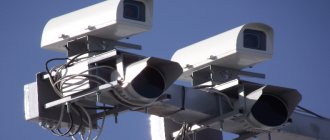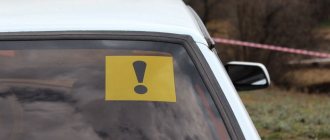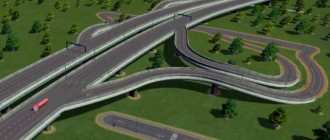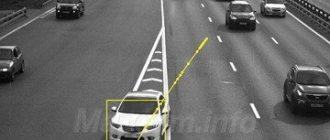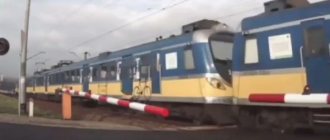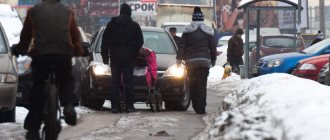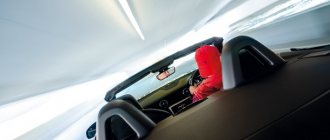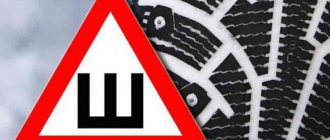In which directions are you allowed to continue driving?
| 1. | Only to the left. |
| 2. | Straight and left. |
| 3. | To the left and in the opposite direction. |
An additional section with a signal turned on in the form of a green arrow, a sign “Driving directions along the lanes” and markings 1.18 allow you to only turn left from the right lane. Traffic is directly prohibited by a red traffic light, and turning is prohibited, since the rules require turning only from the leftmost lane. Turning right is prohibited at any signal.
MOTORIST
Home — Driving Lessons
And yet you cannot do without changing lanes into adjacent lanes. Just don't make rash changes. Each lane change requires the driver to carefully assess the situation around his car (front, rear and sides). If during a lane change the driver does not have time to notice a change in the situation on one side, then a natural accident occurs.
As a rule, the first accident for a “newbie” is associated with changing lanes into the adjacent lane. Therefore, it is very important to choose “your” lane, along which you will move straight for a long time.
Try to avoid unnecessary lane changes! After all, a regular bus will stand at a stop for no more than thirty seconds, and the tractor that crawls in front of you will still turn to the side someday!
If the only way out of the current traffic situation is to change lanes into the adjacent lane, then you must act according to a pre-developed plan.
Rice. 4. Changing lanes into the adjacent lane: a) with acceleration; b) with slowdown
The optimal option for changing lanes is considered to be changing lanes with acceleration and a small angle (5–10°) of deviation from the direction of straight-line movement (Fig. 4 a). We increase the speed, “break away” from the traffic flow and smoothly “merge” into the adjacent lane without disturbing anyone.
To make such a lane change safe for yourself and others, you need to be able to realistically assess the speed of each car with which it is possible to intersect or merge traffic trajectories.
For an “experienced” driver, this option of changing lanes does not cause any difficulties. He has a keen eye, and the speed at which the flow of traffic moves, as a rule, is always lower than that to which he can easily accelerate.
At the same time, a significant increase in speed often becomes the main reason for loss of control of the situation, with the ensuing dire consequences.
Therefore, for novice drivers, at first, a more acceptable option for changing lanes would be to reduce the speed and then smoothly “merge” into the adjacent lane (Fig. 4 b).
With this option of changing lanes, you have to wait for the “tail” of the traffic flow or the “window” in it, thereby creating an obstacle to traffic moving behind you in the same lane. There’s nothing you can do about it; drivers of cars behind you will have to wait a little.
Recently, “gentleman” drivers have begun to appear on the roads, and it is quite possible that from one of them you will receive a “gift” in the form of an invitation to take a seat in the next lane in front of him. Such a “gift” should not be neglected! Indeed, in this case, not only does the waiting time for drivers behind you decrease, but changing lanes itself becomes absolutely safe.
It was a conversation about changing lanes , which requires a lot of attention from the driver and takes a lot of nervous energy from him.
What if you need to cross several lanes ? Do you think a “newbie” will have enough strength to change lanes from the far right to the far left when driving on a four-lane road, and even over a short distance (Fig. 5)? Personally, I'm not sure!
Rice. 5. Changing lanes across multiple lanes
What then should be done in this or a similar case? Is it possible to safely change lanes across multiple lanes at once?
The best recommendation is not to try to do such a rebuild at all! It is better to choose a different route to the intended purpose of the trip. There are almost always two or three possible route options in a city.
However, if in order to achieve the final goal on a wide road, a “newbie” needs to make a left turn or a U-turn, then, of course, there is a way out of this situation.
You need to calmly stop on the right side of the sidewalk at a sufficiently large distance to the place where you intend to turn left or make a U-turn and wait for the red traffic light behind you. The flow of traffic will be interrupted for at least 20–30 seconds. Having waited for the “chopped tail” of the traffic flow, already on an empty road at an angle of 30–45° you can easily cross all the lanes, no matter how many there are. return to contents “Driving Lessons”
Which trajectory do the Rules allow you to make a left turn?
| 1. | Only according to A. |
| 2. | Only according to B. |
| 3. | For any reason. |
The “Lane Directions” sign allows for left turns at this intersection from the middle and left lanes. Therefore, you can turn left either by moving into the leftmost lane in advance, or by continuing in the middle lane, i.e. turning is allowed along any of the specified trajectories.
Number of stripes sign
The “Number of Lanes” sign indicates the number of lanes on the road, as well as the driving modes for each of them:
In accordance with GOST, the sign is installed 50-150 meters before the beginning of the road section, where appropriate prohibitory signs with plate 8.14 are installed above each of the lanes. For example:
In this case, if the requirements of this sign are not observed, the driver will be fined for speeding, depending on the amount of the excess.
The next article will talk about several new signs of special regulations.
Good luck on the roads!
This article will focus on an atypical traffic accident.
The essence of the situation: the driver leaves the yard onto a one-way road, along which an intruder car is moving towards the main flow. At first glance, it may seem that if the driver collides with the offender, he will be right. However, not all so simple.
You intend to turn left. Your actions?
| 1. | Give way to the tram and, making sure that your path does not intersect with an oncoming car, make a turn. |
| 2. | Go through the intersection first. |
A green traffic light gives the right to move to all vehicles. But when turning left, you must give way only to the tram, since your paths will not intersect with an oncoming car.
Unspoken rules
The term lane change itself implies any movement of a car from one lane to another without changing the direction of its movement.
Everything would not be so difficult if there were fewer participants in the movement. But free lanes during rush hour are just a dream. The ability to change lanes correctly in traffic is the key to a safe and enjoyable ride. There are unspoken driving rules that even experienced car enthusiasts should not forget about:
- Before changing lanes, you must show the turn sign. It was at that moment when you just wanted to change lanes, and not when you started turning the steering wheel to the side. This is a warning signal for other road users. Your intentions should always be clear to other drivers.
- We repeat again: no fear. It will only make the situation worse. The only thing more dangerous than an inexperienced motorist who rushes from lane to lane is a drunken novice. You have no right to mislead road users.
- We move in order of priority. You should always remember about the obstacle on the right. And also be prepared to wait if the car in front of you has already started changing lanes.
- Do not forget about the so-called “dead zone”, which is formed due to the limited view of the mirrors. Even such a situation can be foreseen; you just need to turn your head and make sure that the lane you are trying to change lanes into is clear.
- If you notice a hole on the road too late, it is better not to take risks and not change the trajectory of your movement. Other drivers may not react to a sudden maneuver, and the consequences can be truly dire. You should try to avoid sudden movements while driving. If possible, all lane changes should have a smooth trajectory and be deliberate.
- In order to change lanes in heavy traffic without unnecessary difficulties, you need to be a fairly confident driver and not be afraid of ridicule from the outside. You just have to show the turn sign and someone will definitely let you through. Don't forget to thank the emergency crew. This is a kind of road etiquette.
- Be as attentive as possible to drivers of motorcycles and scooters. As a rule, they are young lovers of speed and adrenaline.
- Keep your distance. You should always keep a close eye on vehicles ahead and maintain an appropriate speed limit.
In which directions are you allowed to continue driving?
| 1. | Only to the left. |
| 2. | Only in the opposite direction. |
| 3. | To the left and in the opposite direction. |
An additional section with a green arrow signal on, a “Lane Directions” sign and marking 1.18 allow you to turn left or make a U-turn from the left lane.
U-turn within the intersection.
First of all, you need to focus on signs and markings. As a reminder, just because these symbols tell you not to turn left does not mean you can't make a U-turn on that stretch of road.
The rules do not have clear instructions on how to correctly perform this maneuver, but there is a basic instruction in which vehicles must remain in their lane and not enter the lane of oncoming traffic.
To make a U-turn, you need to take the extreme left position on the lane, turn on the left turn signal and drive to the center of the intersection at the permission signal. If you do not obstruct anyone, complete the maneuver. If you did not have time to make a turn at your traffic light, you can safely complete the maneuver, since other drivers are obliged to let you pass. But you need to be careful, because for other motorists the permit signal will be on, and you may not be noticed.
Now let's look at U-turns at an uncontrolled intersection. The main catch is which road you are on: main or secondary. It will not be easy to turn around from a secondary road, since those on the main road have the advantage. And if the intersection is busy, then this becomes almost impossible. And therefore it is better to choose a different place to turn around. If you are moving along the main road, then a U-turn is usually performed, just like a left turn. You take the extreme left position, turn on the turn signal to the left, and if you do not interfere with traffic that has the right of way, turn around.
You intend to turn right at the intersection. What should you do?
| 1. | Change over to the right lane, then make a turn. |
| 2. | Continue in the second lane until the intersection, then turn. |
| 3. | Both methods are possible. |
The “Lane Directions” sign informs that at this intersection, turning right can be made not only from the right, but also from the left lane. This means that you can turn right, either by moving into the far right lane in advance, or from the second lane.
Rebuilding
Stages of changing direction of movement:
- assessment of the road situation;
- turning on the turn signal;
- check glance in the rearview mirror;
- changing lanes, turning off the turn signal.
Many drivers believe that it is dangerous to change lanes only in heavy traffic. The mistake is that being too relaxed when driving on congested roads dulls your concentration. There is an increased risk of not noticing a motorcycle coming behind you or of ignoring a car in your blind spot. Therefore, changing lanes in any situation requires maximum concentration and confidence from the driver in the maneuver being performed.
How to make sure the maneuver is safe
The main difficulty when changing lanes is the correct assessment of the road situation. You must ensure that there is no other vehicle in the area you occupy when changing lanes. To do this, very often it is not enough just to look in the rearview mirror immediately before starting the maneuver. Firstly, there is a possibility that there is another car in the blind spot next to your car.
A blind spot is a situation in which an object has disappeared from the side rear view mirror, but has not yet appeared in the side window. This area is always wider on the passenger side of the mirror.
Secondly, with a quick glance it is impossible to estimate the speed of approach of the car following you. When you look in the mirror, the distance will indeed be sufficient to change lanes. But by the time the maneuver begins, the car will have time to approach you at a distance that is unsafe for maneuver.
Driving in lanes at an intersection is not the only traffic regulation requirement
Organizing traffic at intersections is the job of special road services, which, based on traffic rules, install the necessary priority signs and traffic lights. It is worth noting that the effect of road signs before the intersection remains valid only in situations where it is a speed limit sign, a sign prohibiting parking, or signs that define a parking area or other signs that have a beginning and an end to the area of validity.
In addition, you need to know that the rules strictly prohibit reversing at an intersection, because this will create a lot of interference for other participants. In addition, it must be remembered that traffic at intersections is carried out in different directions: turn right, left, go straight and others that are allowed by the rules. So it won’t hurt to look around, even if your traffic lights are green at the traffic light, or you are on the main road. Often, due to the presence of many directions, inexperienced drivers can get confused and drive completely against the rules.
It is worth mentioning two fundamentally different types of road intersections that define the 2013 traffic rules; intersections can be regulated and unregulated. The first include sections of roads that are equipped with traffic lights or are constantly attended by a traffic controller. Considering the modern situation, the first option for regulating the intersection is more popular, but the second also has a place in difficult situations. In those controversial cases, when the traffic light is turned off or there is no traffic controller, then movement and maneuvering must be done in accordance with the priority signs that are found at any intersection.
An uncontrolled intersection is defined by traffic rules as a section of road intersection that is equipped with appropriate markings or priority signs.
Stopping and parking on a one-way road
1. Stopping and parking on the right side of one-way roads is carried out in the same way as on two-way roads. Those. if there are no conditions prohibiting stopping (signs, stops, crosswalks, etc.), then you can stop on the right side of the road.
2. Stopping and parking on the left side of one-way roads has some special features.
Stopping and parking on the left side of the road is permitted only in populated areas
Trucks with a permissible maximum weight of more than 3.5 tons cannot park on the left side, but can only stop, and only for loading or unloading. Other cars can stop on the left side of a one-way road without risking a fine.
12.1. On the left side of the road, stopping and parking are permitted in populated areas on roads with one lane for each direction without tram tracks in the middle and on one-way roads (trucks with a permissible maximum weight of more than 3.5 tons are allowed on the left side of one-way roads only stopping for loading or unloading).
If the road contains an oncoming lane for route vehicles, then stopping and parking on the left side of the road is prohibited for all vehicles.
Oncoming traffic lane
The choice of lane is determined by signs, rules and depends on the direction in which the car needs to travel. There are many nuances here. But driving in oncoming traffic especially often raises questions among drivers. In some circumstances, visiting it is possible and necessary, but in most situations it can end in trouble. The oncoming traffic lane according to traffic regulations is used as follows:
- When turning, when the car passes the intersection of roadways, it should not end up in the oncoming traffic. Otherwise, it will be considered a violation regardless of the number of lanes and type of dividing lines.
- When overtaking on a two-way road, moving into oncoming traffic is also prohibited. This applies to areas with four or more lanes.
- You are allowed to go out onto it if you need to overtake, turn around, go to the left, or go around an obstacle. But the road must be three-lane, with markings (except 1.9). And its middle part is intended for driving in both directions.
More on InDrive.Net:
How to correctly interpret the “Turn Left” sign, permitting, prohibiting, is it possible to turn around?
- On a narrow road without dividing lines, you can drive onto it to overtake another vehicle. But there should be no signs prohibiting maneuver nearby.
In the last two cases, the driver will not break the rules. For ignoring the first and second points of the list, Part 4 of Article 12.15 of the Code of Administrative Offenses may be applied to him:
Driving, in violation of the Traffic Rules, onto a lane intended for oncoming traffic, or onto tram tracks in the opposite direction, except for the cases provided for in Part 3 of this article, shall entail the imposition of an administrative fine in the amount of five thousand rubles or deprivation of the right to drive vehicles for a period of four to four years. up to six months.
If the violation was committed in order to bypass a stationary object, use part 3 of the same article:
Driving, in violation of the Traffic Rules, onto a lane intended for oncoming traffic when going around an obstacle, or onto tram tracks in the opposite direction when going around an obstacle, shall entail the imposition of an administrative fine in the amount of one thousand to one thousand five hundred rubles.
